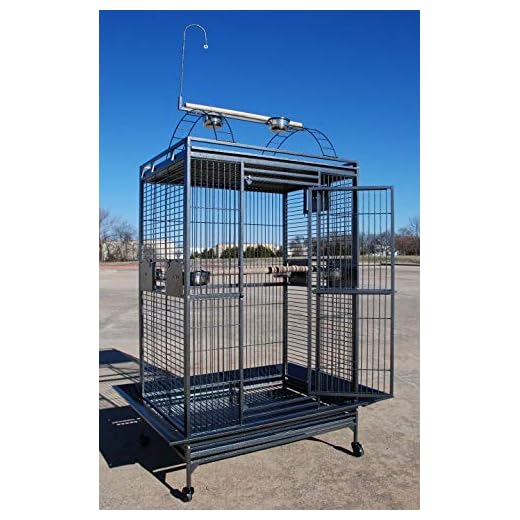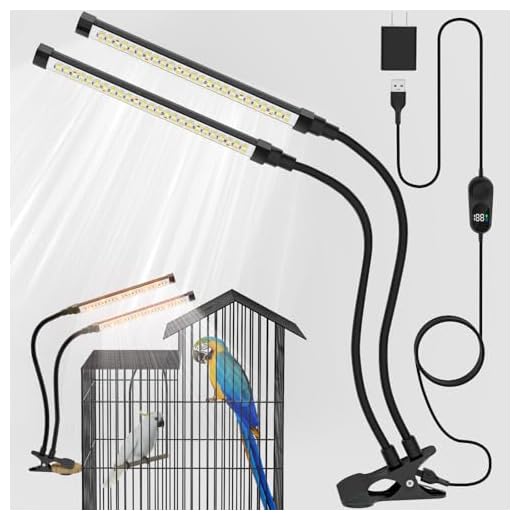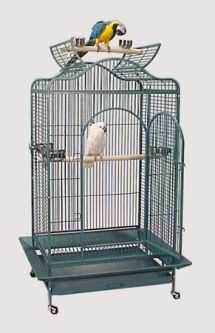




When selecting a suitable environment for your feathered friend, it is crucial to prioritize their comfort and well-being. A spacious enclosure with appropriate dimensions is fundamental for allowing your pet to move freely and exercise. Look for a structure that provides ample room for flapping wings and exploring various levels. A minimum size of 36x24x48 inches is often recommended, but larger options can enhance the living experience.
This article delves into the specific requirements for housing your avian companion, offering insights on materials, design features, and important accessories. It is particularly helpful for current and prospective owners who want to create a nurturing space for their birds. Understanding these factors can significantly enhance your pet’s quality of life.
Within, you’ll find practical tips on selecting safe materials, ensuring proper ventilation, and incorporating stimulating elements such as perches, toys, and climbing structures. By following these guidelines, you can create an inviting and secure environment that caters to your bird’s natural instincts and behaviors.
Ideal Habitat for an Umbrella Cockatoo
Choosing the right environment for an umbrella cockatoo involves several key factors. A spacious enclosure is necessary to accommodate their active nature and provide room for exercise and mental stimulation.
The structure should be made of durable materials, ideally stainless steel or powder-coated metal, to withstand chewing. The spacing between bars must be appropriate to prevent escapes and ensure safety.
Key Features to Consider
- Size: A minimum dimension of 36″ x 48″ x 60″ is recommended to allow free movement.
- Perches: Include multiple perches of varying diameters and materials to promote foot health.
- Toys: Incorporate a variety of toys to encourage mental engagement and prevent boredom.
- Accessibility: Ensure doors and feeding stations are easily reachable for both the bird and the owner.
- Cleaning: A removable tray and easy-to-clean surfaces facilitate maintenance.
Additionally, an enclosure should provide a sheltered area to simulate a natural environment. This can include hiding spots and areas where the bird can feel secure. Lighting is also an important aspect; natural sunlight should be accessible when the bird is outside the habitat.
Ultimately, ensuring a comfortable and enriching environment will promote the well-being of your feathered friend, encouraging a happy and healthy life.
Size Requirements for Cockatoo Housing
The minimum dimensions for a suitable living environment for these birds should be at least 36 inches in width, 48 inches in height, and 24 inches in depth. Larger dimensions are preferable to allow for free movement and comfort. A spacious area is necessary for exercise, as well as to accommodate various toys and perches.
Consideration of the layout is equally important. Vertical space is critical, as these creatures enjoy climbing. Multiple perches at varying heights can significantly enhance their well-being. Horizontal space also plays a role in allowing them to stretch their wings and explore.
Recommended Dimensions
- Minimum width: 36 inches
- Minimum height: 48 inches
- Minimum depth: 24 inches
Expanding on the size requirements, the following factors should also be taken into account:
- Movement: Ensure ample space for the bird to move freely without restrictions.
- Activity: Provide space for toys and accessories that encourage physical and mental stimulation.
- Social Interaction: Allow enough room for interaction with caregivers and other birds, if applicable.
In summary, prioritizing larger dimensions can lead to a healthier and happier life for these intelligent birds.
Material Considerations: Choosing Safe and Durable Options
Selecting the right materials is fundamental for creating a safe and long-lasting environment for your feathered friend. Stainless steel stands out as an excellent choice due to its resistance to rust and corrosion, ensuring that it maintains its integrity over time. This material also minimizes the risk of toxic exposure from coatings that can wear off.
Another durable option is powder-coated metal, which is often used for enclosures. It provides a protective barrier against wear and tear while being available in various colors. However, ensure that the coating is non-toxic, as some finishes can pose health risks if ingested or scratched.
Choosing Safe and Long-lasting Materials
- Stainless Steel: Resistant to rust, easy to clean, and non-toxic.
- Powder-Coated Metal: Durable and visually appealing, but check for non-toxic finishes.
- Wood: Natural and aesthetically pleasing; must be untreated and safe for birds.
- Plastic: Lightweight and versatile, though durability can vary; opt for high-quality, bird-safe options.
Be cautious with materials like untreated wood or low-quality plastic, as they may splinter or break down, posing hazards. Always verify that any material used is free from harmful chemicals and suitable for avian use. Prioritize long-lasting options to reduce the need for frequent replacements, which can disrupt the comfort of your pet.
Design Features that Promote Comfort and Well-Being
Choosing an appropriate habitat for a feathered companion requires careful attention to specific design features that enhance their comfort and overall happiness. A spacious environment allows for free movement, enabling these intelligent birds to stretch their wings and engage in natural behaviors. The layout should include various perches at different heights, catering to their instinct to climb and explore.
Another significant aspect is the inclusion of enrichment elements within the living space. Natural materials, such as untreated wood and rope, can provide opportunities for chewing and climbing, which are essential for mental stimulation. Additionally, the provision of toys that challenge their problem-solving skills contributes to their well-being.
Key Design Elements
- Ventilation: Adequate airflow is critical to maintaining a healthy environment. Proper ventilation prevents the buildup of humidity and odors.
- Safety Features: Smooth edges and non-toxic materials ensure the safety of the bird. Avoiding small openings prevents accidental escapes or injuries.
- Accessibility: Large doors and easy access points allow for convenient interaction and maintenance, reducing stress during cleaning and feeding.
- Customizable Spaces: Modular designs enable owners to rearrange elements, allowing for a dynamic environment that can adapt to the bird’s preferences.
- Play Areas: Dedicated spaces for play and exploration encourage physical activity and mental engagement, essential for a happy and healthy pet.
Incorporating these features not only creates a secure habitat but also enhances the quality of life for these social creatures. A thoughtfully designed space promotes their natural instincts and contributes to their emotional well-being.
Ventilation and Lighting: Creating a Healthy Environment
Proper air circulation is fundamental when setting up a habitat for a feathered companion. Stagnant air can lead to respiratory problems and an accumulation of harmful bacteria. Ensure that the enclosure has adequate openings that allow fresh air to flow freely, while still providing security and comfort to the bird.
Natural and artificial light play a significant role in maintaining the well-being of your avian friend. Exposure to sunlight is crucial for vitamin D synthesis, which supports calcium absorption. A well-lit space not only boosts mood but also encourages natural behaviors.
Key Aspects of Ventilation and Lighting
- Airflow: Aim for a design that allows cross-ventilation. This can be achieved with multiple openings, strategically placed to promote airflow without creating drafts.
- Natural Light: Position the habitat in a location where it can receive natural sunlight for several hours daily, while providing shaded areas to escape direct sun during peak hours.
- Artificial Lighting: Utilize full-spectrum bulbs that mimic natural sunlight. This helps in maintaining the bird’s circadian rhythm, enhancing overall health and well-being.
- Humidity Control: Monitor humidity levels, as both high and low humidity can affect respiratory health. Introducing a humidifier or dehumidifier can help maintain optimal conditions.
Creating a balanced environment with proper ventilation and lighting ensures a healthier life for your feathered companion. Regularly assess the habitat and make adjustments as necessary to maintain an optimal living space.
Convenient Accessories for Play and Enrichment
Incorporating various accessories into the habitat can significantly enhance the well-being and happiness of your feathered friend. Items such as swings, ladders, and climbing structures provide essential physical activity, which is crucial for maintaining optimal health and preventing boredom.
Interactive toys that encourage problem-solving are particularly beneficial. These can include puzzles that dispense treats, foraging toys that require manipulation, and items that stimulate natural behaviors. Such enrichment fosters mental engagement and keeps your pet entertained.
Recommended Accessories
- Swings and Perches: Adjustable swings and multiple perches at varying heights encourage climbing and movement.
- Foraging Toys: Toys that require birds to search for food promote natural instincts and provide mental challenges.
- Ropes and Climbing Structures: These allow for exercise and exploration, mimicking their natural environment.
- Mirrors: They can stimulate curiosity and social interactions, although they should be used cautiously to avoid over-attachment.
Regularly rotating and introducing new accessories can keep the environment stimulating. This not only maintains your pet’s interest but also encourages exploration and play. Observing your bird’s preferences can guide you in selecting the most engaging items.
Consider the safety of all accessories. Ensure that materials are non-toxic and that there are no small parts that could be swallowed. Creating a safe and enriching environment is fundamental for a happy and healthy bird.
Maintenance Tips for a Clean and Safe Habitat Setup
Regular cleaning is paramount. Remove uneaten food and droppings daily to prevent bacteria growth. Weekly deep cleaning involves washing the surfaces with bird-safe cleaning solutions and disinfecting toys and perches.
Ensure that all materials are non-toxic. Avoid using paint or varnish that can emit harmful fumes. Opt for stainless steel or untreated natural wood for a safe environment.
- Daily Tasks:
- Check and refill fresh water.
- Remove waste and uneaten food.
- Inspect toys and perches for wear and tear.
- Weekly Tasks:
- Wash surfaces with bird-safe cleaners.
- Soak and scrub toys with warm water.
- Change bedding material if used.
- Monthly Tasks:
- Disinfect the entire habitat setup.
- Replace any worn or damaged items.
- Inspect the structure for any safety hazards.
Monitoring temperature and humidity is equally important. Maintain a comfortable range to promote health and well-being. Avoid locations with drafts or direct sunlight.
In conclusion, a clean and safe habitat setup involves routine cleaning, careful selection of materials, and regular monitoring of environmental conditions. By adhering to these guidelines, you can create a healthy and happy living space for your feathered companion.
Best cage for an umbrella cockatoo
Features
| Model | 12728 |
| Color | Black Vein |
| Size | 35.5"L x 30.5"W x 66"H |
Features
| Color | Black |
Features
| Part Number | YT-00074264 |
| Model | Y00845A |
| Warranty | 1 year manufacturer |
| Color | Black |
| Is Adult Product | |
| Size | 31.1"L x 20.4"W x 52.0"H |
Features
| Part Number | AIR042 |
| Model | AIR042 |
| Color | Grey |
| Size | 32.7 x 30.9 x 70.8 inches |
Features
| Part Number | BS-01 |
| Model | BS-1 |
| Warranty | 2 year manufacturer. |
Features
| Part Number | Impossi-Ball |
| Model | Impossi-Ball |
| Color | Impossi-Ball |
Video:
FAQ:
What size cage is recommended for an umbrella cockatoo?
For an umbrella cockatoo, a cage that is at least 30 inches wide, 30 inches deep, and 40 inches tall is recommended. These birds are known for their playful and active nature, so having enough space to move around, stretch their wings, and explore is crucial. It’s also important that the cage has horizontal bars to facilitate climbing and play. A larger cage is always better, as it allows for the addition of toys and perches, which can contribute to their mental and physical well-being.
What features should I look for in a cage for my umbrella cockatoo?
When choosing a cage for your umbrella cockatoo, consider the following features: first, the material should be durable and non-toxic, such as stainless steel or powder-coated metal, to ensure the safety of your bird. The cage should have multiple perches at varying heights to encourage exercise and exploration. Look for a design that includes removable trays for easy cleaning, as maintaining hygiene is essential for your bird’s health. Additionally, having plenty of space for toys is important, as cockatoos require mental stimulation to prevent boredom. Ensure the cage has secure locking mechanisms to prevent escapes, as these birds are quite clever and can figure out how to open simple latches.








